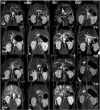Decreased risk of cholangiocarcinogenesis following repeated cycles of Opisthorchis viverrini infection-praziquantel treatment: Magnetic Resonance Imaging (MRI) and histopathological study in a hamster model
- PMID: 27143606
- PMCID: PMC5086443
- DOI: 10.1016/j.parint.2016.04.012
Decreased risk of cholangiocarcinogenesis following repeated cycles of Opisthorchis viverrini infection-praziquantel treatment: Magnetic Resonance Imaging (MRI) and histopathological study in a hamster model
Abstract
It has been suggested that repeated infection of Opisthorchis viverrini followed by repeated treatment with praziquantel (PZQ) increases risk of development of cholangiocarcinoma (CCA). Evidence for the prediction has accumulated based on findings of indirect approaches involving molecular changes and epidemiological trends. By contrast, here we directly monitored the impact of repeated liver fluke infection and treatment with PZQ on cholangiocarcinogenesis in a rodent model of human opisthorchiasis, using magnetic resonance imaging (MRI) and histopathology. Twenty five Syrian golden hamsters were assigned to five treatment groups: 1) infection with O. viverrini (OV group), 2) treatment with the carcinogen N-nitrosodimethylamine (NDMA) at 12.5ppm (DMN), 3) O. viverrini infection in tandem with NDMA (OD), 4) O. viverrini infection, NDMA, and treatment with PZQ (ODP), and 5) uninfected, untreated control. The repeated infections were established by intragastric inoculation of 50 metacercariae of O. viverrini to the OV, OD and ODP hamsters at weeks 0, 5 and 10. PZQ at 300mg/kg body weight was given to each hamster of the ODP group on weeks 4, 9 and 13 (four weeks after each infection). Imaging by MRI was undertaken on weeks 5, 10 and 14 (i.e. one week after each PZQ treatment). MRI revealed that the ODP hamsters did not develop CCA, whereas necropsy at week 40 revealed CCA in hamsters of the OD and DMN groups. Findings for histopathology and for proliferating cell nuclear antigen index conformed to the MRI findings. In overview, and notwithstanding that the immune response of individual hosts may play roles in cholangiocarcinogenesis, three cycles of the infection with O. viverrini followed treatment of the infection with PZQ did not increase the risk of bile duct cancer in this hamster model of liver fluke infection-induced CCA.
Keywords: Cholangiocarcinoma; Hamster; MRI; Opisthorchis; Praziquantel; Repeated infection.
Copyright © 2016 Elsevier Ireland Ltd. All rights reserved.
Figures



Similar articles
-
Combination of Praziquantel and Aspirin Minimizes Liver Pathology of Hamster Opisthorchis viverrini Infection Associated Cholangiocarcinoma.Pathol Oncol Res. 2016 Jan;22(1):57-65. doi: 10.1007/s12253-015-9967-y. Epub 2015 Aug 16. Pathol Oncol Res. 2016. PMID: 26277607
-
Cholangiocarcinoma in experimental hamsters with long-standing Opisthorchis viverrini infection.Asian Pac J Cancer Prev. 2009 Apr-Jun;10(2):299-302. Asian Pac J Cancer Prev. 2009. PMID: 19537899
-
Granulin Expression in Hamsters during Opisthorchis viverrini Infection-Induced Cholangiocarcinogenesis.Asian Pac J Cancer Prev. 2018 Sep 26;19(9):2437-2445. doi: 10.22034/APJCP.2018.19.9.2437. Asian Pac J Cancer Prev. 2018. PMID: 30255697 Free PMC article.
-
[Control of Opisthorchis viverrini infection for cholangiocarcinoma prevention].Bull Soc Pathol Exot. 2017 Feb;110(1):61-67. doi: 10.1007/s13149-017-0544-8. Epub 2017 Jan 19. Bull Soc Pathol Exot. 2017. PMID: 28105582 Review. French.
-
Association between praziquantel and cholangiocarcinoma in patients infected with Opisthorchis viverrini: a systematic review and meta-analysis.Asian Pac J Cancer Prev. 2013;14(11):7011-6. doi: 10.7314/apjcp.2013.14.11.7011. Asian Pac J Cancer Prev. 2013. PMID: 24377641
Cited by
-
Effects of Three-time Administration of a Supramolecular Complex of Praziquantel with Disodium Glycyrrhizinate on Trematode Opisthorchis felineus in Hamsters.Acta Parasitol. 2021 Jun;66(2):623-630. doi: 10.1007/s11686-020-00329-5. Epub 2021 Jan 8. Acta Parasitol. 2021. PMID: 33420597
-
Evaluation of sectional anatomic, micro-computed tomographic, and magnetic resonance imaging features of the thorax in Syrian hamsters (Mesocricetus auratus).Vet Res Commun. 2025 Jan 16;49(2):81. doi: 10.1007/s11259-025-10649-4. Vet Res Commun. 2025. PMID: 39821859
-
Inflammatory responses to Opisthorchis viverrini infection in animal models: A comparison between susceptible and nonsusceptible hosts in different anatomical locations.Open Vet J. 2024 Feb;14(2):664-673. doi: 10.5455/OVJ.2024.v14.i2.6. Epub 2024 Feb 29. Open Vet J. 2024. PMID: 38549578 Free PMC article.
-
Liver Fluke-Associated Biliary Tract Cancer.Gut Liver. 2018 May 15;12(3):236-245. doi: 10.5009/gnl17102. Gut Liver. 2018. PMID: 28783896 Free PMC article. Review.
-
The antioxidants resveratrol and N-acetylcysteine enhance anthelmintic activity of praziquantel and artesunate against Schistosoma mansoni.Parasit Vectors. 2019 Jun 20;12(1):309. doi: 10.1186/s13071-019-3566-9. Parasit Vectors. 2019. PMID: 31221193 Free PMC article.
References
-
- Sripa B, Kaewkes S, Intapan PM, Maleewong W, Brindley PJ. Food-borne trematodiases in Southeast Asia epidemiology, pathology, clinical manifestation and control. Adv Parasitol. 2010;72:305–350. - PubMed
MeSH terms
Substances
Grants and funding
LinkOut - more resources
Full Text Sources
Other Literature Sources
Medical

